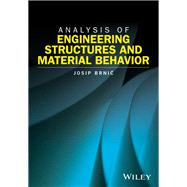Theoretical and experimental study of the mechanical behavior of structures under load
Analysis of Engineering Structures and Material Behavior is a textbook covering introductory and advanced topics in structural analysis. It begins with an introduction to the topic, before covering fundamental concepts of stress, strain and information about mechanical testing of materials. Material behaviors, yield criteria and loads imposed on the engineering elements are also discussed. The book then moves on to cover more advanced areas including relationships between stress and strain, rheological models, creep of metallic materials and fracture mechanics. Finally, the finite element method and its applications are considered.
Key features:
- Covers introductory and advanced topics in structural analysis, including load, stress, strain, creep, fatigue and finite element analysis of structural elements.
- Includes examples and considers mathematical formulations.
- A pedagogical approach to the topic.
Analysis of Engineering Structures and Material Behavior is suitable as a textbook for structural analysis and mechanics courses in structural, civil and mechanical engineering, as well as a valuable guide for practicing engineers.








